变废为宝主题班会(精品课件)
- 格式:pptx
- 大小:11.98 MB
- 文档页数:21
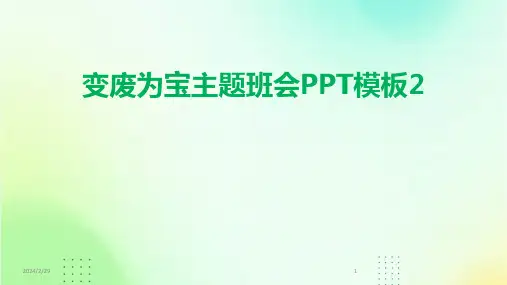

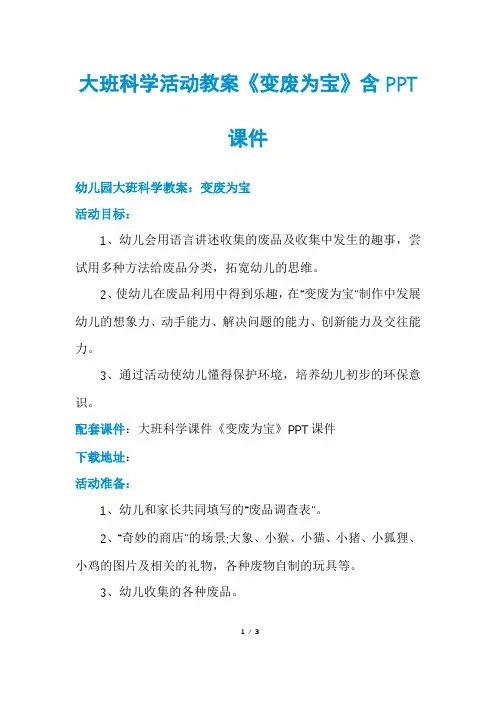
大班科学活动教案《变废为宝》含PPT课件幼儿园大班科学教案:变废为宝活动目标:1、幼儿会用语言讲述收集的废品及收集中发生的趣事,尝试用多种方法给废品分类,拓宽幼儿的思维。
2、使幼儿在废品利用中得到乐趣,在“变废为宝”制作中发展幼儿的想象力、动手能力、解决问题的能力、创新能力及交往能力。
3、通过活动使幼儿懂得保护环境,培养幼儿初步的环保意识。
配套课件:大班科学课件《变废为宝》PPT课件下载地址:活动准备:1、幼儿和家长共同填写的“废品调查表”。
2、“奇妙的商店”的场景;大象、小猴、小猫、小猪、小狐狸、小鸡的图片及相关的礼物,各种废物自制的玩具等。
3、幼儿收集的各种废品。
1/ 3活动过程:2.幼儿讲述收集的废品及收集趣事。
(1)在我们生活中每天也有许多废品,前几天我们还做过“收集废品”的调查,请与你旁边的小朋友互相说说你收集了哪些废品,在收集过程中发生的有趣、好玩的事也可以说一说。
(2)请2-3位幼儿介绍调查表,说说收集中发生的趣事。
3.鼓励幼儿尝试用多种方法给废品分类。
(1)你们看,这些纸箱里就是小朋友从家中收集来的废品,这么多摆放在一起很乱,有什么好方法让这些废品摆放整齐?幼儿说方法:如相同物品放一起。
如瓶子一堆、盒子一堆等,幼儿动手摆放箱中的废品。
你觉得还有哪些废品摆放得不合适?请1-2位幼儿检查摆放。
(2)除了这样分,你还能想出其它更好的分法吗?教师鼓励幼儿想出各种不同分法如:盒子分(糖盒、牙膏盒、鞋盒);瓶子(洗发瓶、药瓶、饮料瓶)等。
(3)教师适时地抓住教育契机引导幼儿按废品材料进行分类。
如幼儿说:可以把纸做的东西放一起。
找找还有哪些是纸做的?看看还有的废品是什么材料做的?幼儿说出金属类、玻璃类、塑料类等,并找找相关的废品有哪些?商讨分别放哪更合适?幼儿按材料再次对废品进行分类。
师生共同检查分类情况,2/ 3对摆放不合适的废品,请幼儿帮忙送到该类废品材料中。
4.说说废品的利用。
(1)提问:收集来的废品怎样利用?(有的废品可以“变废为宝,保护环境,防止污染;有的废品可以回收、利用,节约资源。
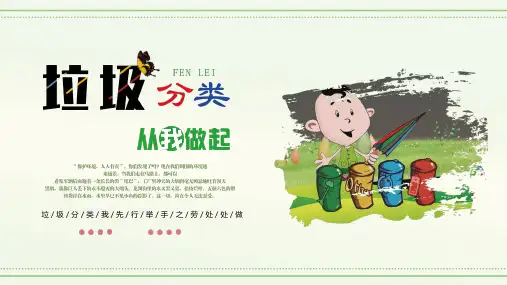
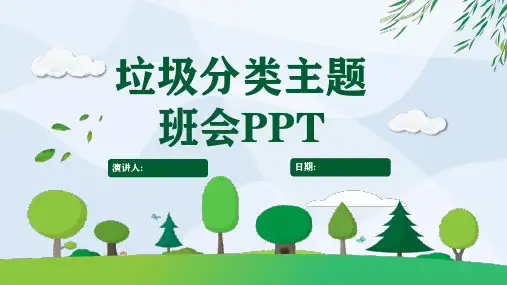
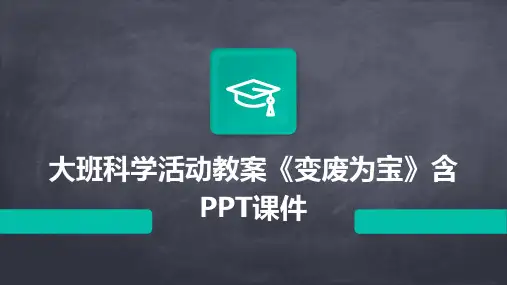
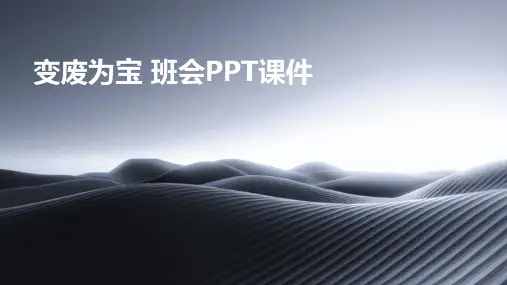
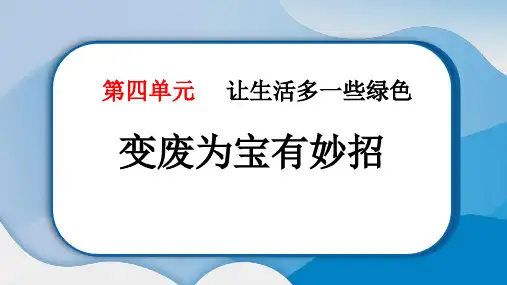
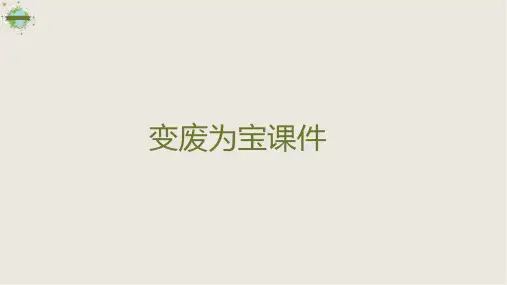
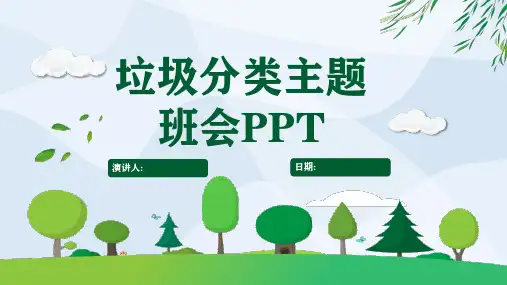
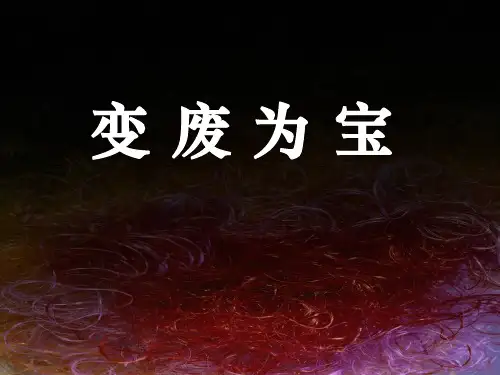
大班科学《变废为宝》精品课件+精品教案+配音一、教学内容本节课选自大班科学领域,主题为《变废为宝》。
教材的章节为第四章“生活中的科学”,详细内容涉及废物利用、环保意识、创新思维等方面。
二、教学目标1. 让幼儿了解废物利用的意义,提高环保意识。
2. 培养幼儿的创新思维和动手能力,学会将废物变为有用的物品。
3. 增进幼儿对科学的兴趣,激发探索欲望。
三、教学难点与重点难点:废物利用的方法和技巧。
重点:培养幼儿的环保意识和创新思维。
四、教具与学具准备教具:PPT课件、实物展示、配音设备。
学具:废纸、瓶子、盒子、剪刀、胶水、彩笔等。
五、教学过程1. 导入:通过展示废纸、瓶子等物品,引发幼儿思考如何将这些废物变为有用的物品。
2. 新课导入:播放PPT课件,讲解废物利用的方法和技巧,引导幼儿关注环保问题。
3. 实践环节:a. 教师演示:利用废纸制作纸袋,讲解制作过程和注意事项。
b. 幼儿动手操作:分组进行废物利用实践活动,将废纸、瓶子等变为有趣的玩具或实用物品。
c. 互动交流:展示幼儿作品,进行评价和分享。
4. 例题讲解:讲解如何将一个废瓶子变为小花盆,引导幼儿学会观察、思考和创新。
5. 随堂练习:让幼儿尝试用其他废物进行创意制作,巩固所学知识。
六、板书设计1. 《变废为宝》2. 内容:a. 废物利用的意义b. 常见废物利用方法c. 环保意识与创新思维七、作业设计1. 作业题目:用身边的废物制作一个实用或有趣的物品。
2. 答案:略。
八、课后反思及拓展延伸1. 反思:关注幼儿在实践环节的参与度,提高教学效果。
2. 拓展延伸:a. 家园共育:鼓励家长参与废物利用活动,共同培养幼儿的环保意识和创新思维。
b. 环保主题活动:组织幼儿参加社区环保活动,将所学知识运用到实际中。
c. 创新展示:定期举办废物利用创意大赛,激发幼儿的创造潜能。
重点和难点解析1. 教学难点与重点的确定2. 实践环节的教学设计3. 作业设计及课后反思拓展延伸一、教学难点与重点的确定1. 教学中应充分运用实物展示、PPT课件、配音等多种教学手段,使幼儿直观地了解废物利用的方法和技巧。
变废为宝主题班会pptSlide 1: Introduction- Welcome everyone to today's class meeting.- Today, we will discuss the theme of "Turning Waste into Treasure" and explore ways to be resourceful and creative.Slide 2: Definition of Waste- Waste refers to any material or substance that is discarded as useless, unwanted, or surplus.- It can include organic waste, packaging materials, electronic waste, and more.Slide 3: The Impact of Waste- The growing amount of waste causes serious environmental problems, such as pollution and climate change.- Improper waste disposal leads to the contamination of water, soil, and air.- Landfills contribute to greenhouse gas emissions.Slide 4: Recycling- Recycling is an effective way to turn waste into treasure.- It involves converting waste materials into reusable materials.- Examples of recyclable items include paper, plastic, glass, and metals.Slide 5: Upcycling- Upcycling is the process of transforming waste materials into products of higher value or quality.- It encourages creativity and innovation.- Examples of upcycled products include furniture made from oldpallets or jewelry made from discarded bottle caps.Slide 6: Composting- Composting is the natural decomposition of organic waste into nutrient-rich soil.- It reduces the amount of waste sent to landfills.- The resulting compost can be used as fertilizer for gardens and plants.Slide 7: Repurposing- Repurposing involves giving new purpose or function to old or discarded items.- For example, using glass jars as candle holders or turning old clothing into reusable bags.- This reduces waste and promotes sustainability.Slide 8: The Benefits of Turning Waste into Treasure- Reduces pollution and environmental impact.- Saves natural resources.- Stimulates creativity and innovation.- Creates economic opportunities in the recycling and upcycling industries.Slide 9: Examples of Successful Waste-to-Treasure Projects- Share inspiring stories or case studies of individuals or companies that have successfully implemented waste-to-treasure initiatives. Slide 10: Conclusion- Emphasize the importance of changing our mindset towards waste.- Encourage everyone to explore ways to turn waste into treasure in their daily lives.- Thank you for actively participating in today's discussion. Note: The provided PowerPoint slides contain the main ideas and content for the presentation. Remember to add relevant images and graphics to enhance visual appeal and engagement.。